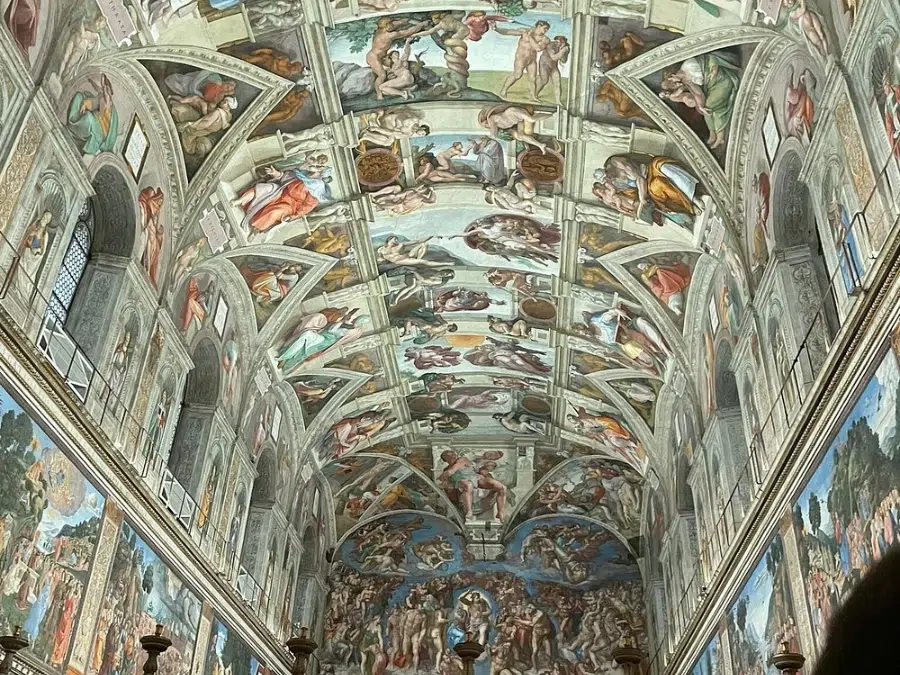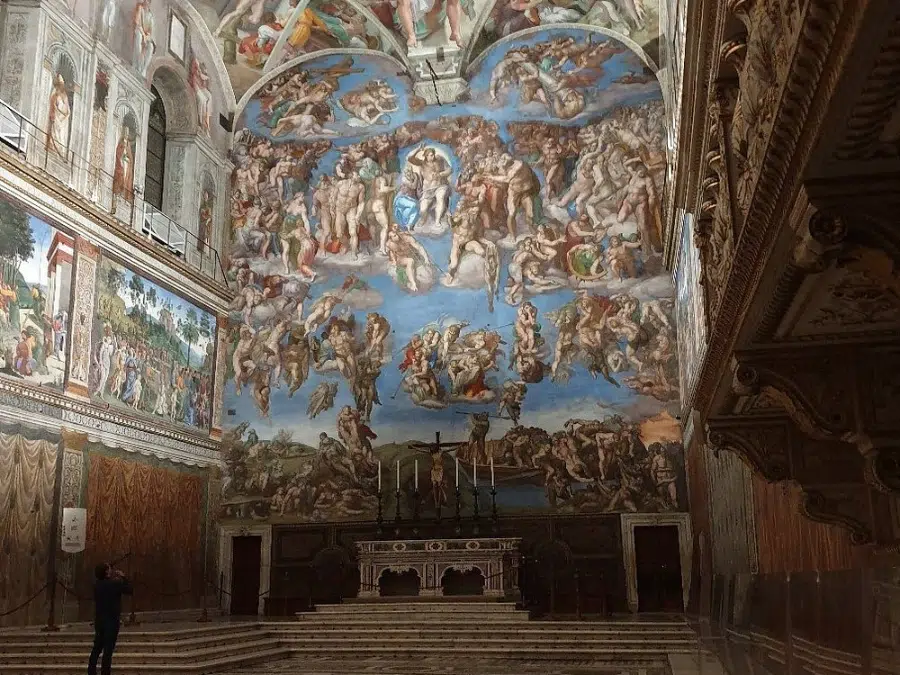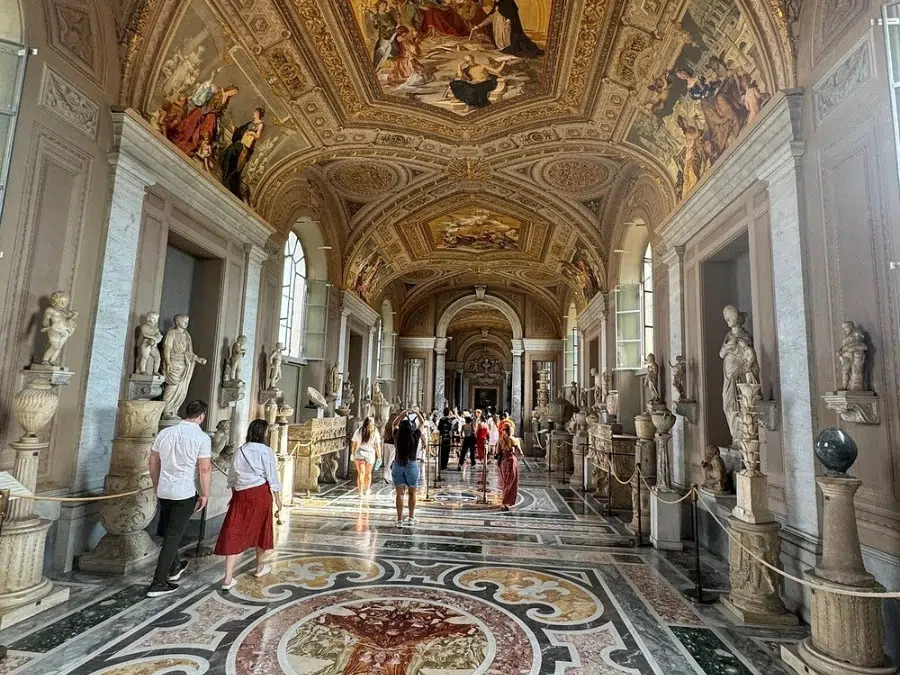The Sistine Chapel is the renowned and most visited part of the Vatican Museums. It was mostly built between 1508 and 1512. About 25,000 visitors visit Vatican City and the museums daily for their cultural, historical, and religious significance.
It gained popularity with the contributions of Michelangelo, with his famous “The Last Judgement” and “The Creation of Adam” paintings in the hall. This article discusses everything about the Sistine Chapel, its highlights, timings, ideal to visit, and much more!
Snapshot
Timings: 8 am to 7 pm
Tour Duration: 30 minutes
Best time to visit: 8 am to 11 am
Ticket Price: €31
About Sistine Chapel
The Sistine Chapel is named after Pope Sixtus IV, who initiated the ‘Great Chapel’ decoration from 1477 onwards which involved stories of Moses and Christ and portraits of Popes on the walls and ceilings. Artists like Perugino, Sandro Botticelli, Domenico Ghirlandaio, and Cosimo Rosselli created art.
Julius II later initiated the redecoration and alteration of the Holy Chapel, thereby entrusting the work to Michelangelo. The Sistine Chapel was inaugurated in November 1512 with a solemn mass. Not just its splendid frescoes and art collections, the Sistine Chapel is the place for all papal conclaves, baptisms, and official ceremonies of the Pope in Vatican City.
It consists of colorful paintings that depict stories of life and Christianity as a whole. The stories of Genesis, from creation to the fall of man, the flood, and the subsequent rebirth of mankind with the family of Noah, are depicted in nine central panels of the hall. The chapel’s artwork is divided into five categories that are explained below:
Ceiling

Michelangelo painted the ceiling, the upper part of the walls and the lunettes. The pendentives feature paintings of the twelve apostles, while the remaining areas feature decorative motifs. Michelangelo used powerful painted architecture in the central nine panels, illustrating episodes of Genesis, ‘The Creation of Adam’ with nude figures at its sides, and holding decorations with texts from the Book of Kings.
At the base, paintings of twelve prophets and sibyls seated on monumental thrones are painted in the spandrels and arches. The four corners of the ceiling illustrate some episodes of the miraculous salvation of the people of Israel.
Altar Wall with ‘The Last Judgment’

This wall of the Sistine Chapel is famous for Michelangelo’s “The Last Judgment” painting above the altar. It starts from the ceiling and goes down to the wooden panel and the altar for about 21 m (69 feet). It presents all the episodes and the people involved during Christ’s last judgment.
This magnificent piece of art gained a lot of praise and strong controversy for having so many nude figures in an honored or sacred place. Volterra was tasked with painting the covering drapery, which he started, and others were added in the later centuries.
North Wall
The upper frieze, painted by Perugino on the altar wall, originally contained eight panels with titles presenting the stories of Christ. However, it was subsequently destroyed to make room for Michelangelo’s “The Last Judgment.”
The main presentation of the Northern Wall includes the events of the life of Christ:
- Christ’s Baptism
- Temptations of Christ
- Calling of the Apostles Peter and Andrew,
- Sermon on the Mount
- Curing of the Leper,
- Handing over of the keys ( transfer of power from Christ to Peter),
- Attempted stoning of Christ,
- Last Supper,
- Arrest of Jesus,
- the Crucifixion, and
- Resurrection of Christ
South Wall
The south wall primarily includes the stories of Moses, which originally included eight panels on the upper frieze, starting from the altar wall.
Some of the paintings include:
- Journey of Moses in Egypt.
- Events of Moses’ life
- Punishment of Korah and Dathan e Abiram, the Jewish priests who denied Moses and Aaron civil and religious authority
- Legacy and death of Moses
The display painting ends on the entrance wall with a dispute over the body of Moses. Instead of following a wall, their series alternates with the wall on the other side.
Entrance Wall
The frescoes on this wall depict the two last episodes of the cycles of Moses and Christ:
- the Resurrection of Christ
- the Discussion over the body of Moses
Similar to the stories of Christ’s and Moses’ lives on the north and south walls, some Popes are depicted from a high viewpoint, and the lower register has false draperies.
Uncover Vatican!
Book curated experiences handpicked by our world-trusted partners.
Opening Hours
The Sistine Chapel is one of the rooms inside the Vatican Museum, so it follows the same timings as the museum. The Vatican Museum and Sistine Chapel opens at 8 am and closes at 7 pm throughout the week with a little alterations. Check our article on the Vatican Museum’s timings to know the detailed operating hours.
Best Time to Visit the Sistine Chapel

We recommend that you visit it at 8 am, just when the museums open, until 11 am to get a crowd-free experience of the Sistine Chapel. Another suitable time can be a couple of hours before the museums close, around 3 or 4 pm, when most visitors leave the premises.
Go on weekdays, Mondays, Tuesdays, and Thursdays, which are ideal except Wednesdays, for the papal audience in St. Peter’s Basilica. Opt for the non-peak season between November and March, as the temperature won’t affect you much for the indoor visits.
Tour Duration
The Sistine Chapel tour lasts 30 to 45 minutes, depending on how much time you want to spend inside. If you just want to view the Sistine Chapel and leave, then head straight there and spend a good amount of time there. There are no restrictions on how much you can spend inside the chapel; however, be considerate of other visitors, complete your visit, and leave the hall.
Things to Remember
- While visiting the sacred place, you must dress in clothes that do not expose the major parts of your body.
- Wear clothes covering your knees, shoulders, chest, and midriff. For example, full pants/ jeans, shirts or dresses with sleeves, buttoned clothes covering the chest and belly, etc.
- You must maintain strict silence inside the Sistine Chapel.
- Remember that even during guided or private tours, the guide introduces you to the Sistine Chapel and enters the hall.
- Don’t visit on the last Sunday of any month; it is free entry and can get crowded. You would hardly be able to see anything inside. Check our visiting tips.
- No photography or videography is allowed inside the chapel.
- It is dimly lit and has a temperature-controlled hall to preserve the room’s artwork.
- Wednesdays can get crowded, and the hall can even remain closed during papal ceremonies.
Insider Tip: If you are visiting the Sistine Chapel and then want to go to St. Peter’s Basilica, there is a small secret door less frequented by the general public. You can quickly enter the basilica with a guided tour, provided the door is kept open
Sistine Chapel Tickets:
To enter the Sistine Chapel, you don’t need to buy a separate ticket; you can use the same Vatican Museum entry ticket, as it is part of the museum. Here are some of the best tickets available to make your tour memorable and worthwhile.
| Ticket Type | Price |
|---|---|
| Entry Ticket | €31 |
| Guided Tour | €115 |
| Private Tour | €329 |
| Night Tour | €310 |
Is the visit to the Sistine Chapel worth it?
The Sistine Chapel is a jewel on the crown of the Vatican Museums and is considered a must-see for its amazing beauty and historical significance. It draws numerous tourists on religious visits, art lovers, and history buffs. The paintings of the stories of Genesis, Christ, and Moses, as well as the famous “Last Judgement” and “The Creation of Adam,” make it an unparalleled representation of Christianity and art.
Starting from the ceiling to the frescoes, arches, walls, and lunettes, each has its own distinct and magnificent decorations that catch the eye of the visitors. Not just its art collections; as a place that holds papal ceremonies, induction of the new pope, baptisms, etc., its religious significance makes it more sacred.
Though many people visit here, the Sistine Chapel maintains its sanctity and peace inside. However, whether it is worth the visit depends on your interests and the outcome you expect. But for lovers of art and history and a Catholic follower, the Sistine Chapel visit is worth it.




